Backyard bird feeders offer a natural way to reduce anxiety and stress in your daily life. By attracting a variety of feathered friends, you'll create a soothing environment filled with melodic birdsong that triggers dopamine release and promotes relaxation. Choose the right feeder and seeds to attract local species, and create a bird-friendly garden to enhance your backyard oasis. Regular bird watching can improve your mood, boost cognitive function, and provide a much-needed connection to nature. Involving family members in this peaceful hobby can strengthen bonds and foster appreciation for wildlife. Discover how these simple additions to your outdoor space can transform your mental well-being and local ecosystem.
The Calming Power of Birdsong
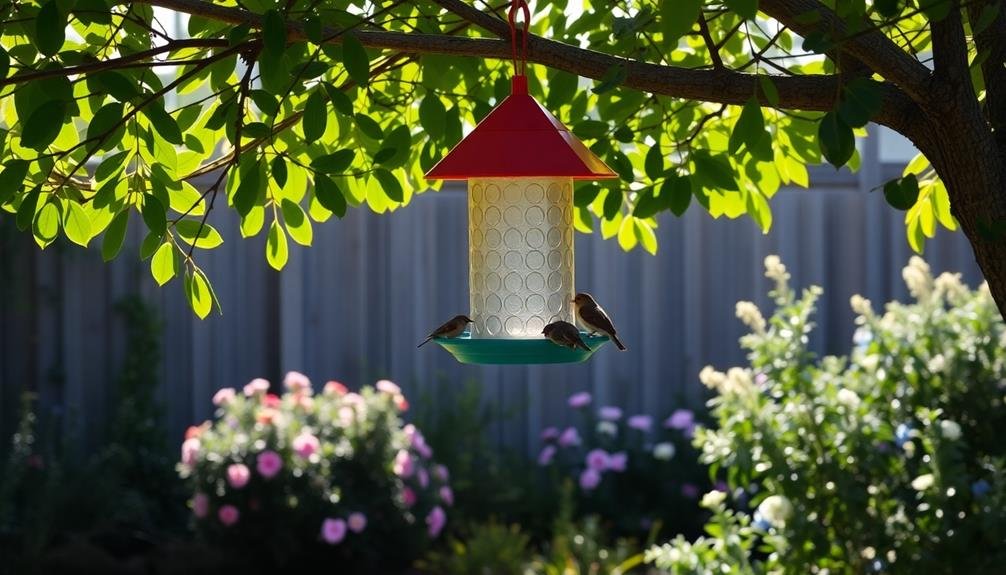
Why does the gentle chirping of birds have such a soothing effect on our minds? It's not just your imagination; science backs up the calming influence of birdsong.
When you hear birds singing, your brain releases dopamine, a feel-good chemical that boosts mood and reduces stress. This natural soundscape can lower your heart rate and blood pressure, promoting a sense of relaxation and well-being.
Birdsong also acts as a form of mindfulness, drawing your attention to the present moment and away from anxious thoughts. It's a gentle reminder of the world beyond your immediate concerns, helping to put your worries into perspective.
Unlike harsh urban noises, the melodic tunes of birds are predictable yet varied, creating a pleasant auditory environment that doesn't overwhelm your senses.
Choosing the Right Bird Feeder
When it comes to choosing the right bird feeder, you'll want to contemplate several factors to attract a diverse array of feathered visitors.
Consider the types of birds in your area and their feeding habits. Platform feeders are versatile and can accommodate various bird species, while tube feeders are ideal for small songbirds. Hopper feeders work well for larger birds and can hold more seed.
Think about the materials used in the feeder's construction. Opt for durable, weather-resistant options like metal or recycled plastic. These will withstand the elements and last longer.
Make certain the feeder has proper drainage to prevent seed from becoming moldy.
Don't forget about accessibility and cleanliness. Choose feeders that are easy to clean and refill. Some models come apart for thorough cleaning, which is vital for maintaining bird health.
Placement is significant too. Position your feeder near natural shelters like trees or shrubs, but keep it visible from your favorite viewing spot.
Lastly, consider squirrel-proofing measures if these furry critters are prevalent in your area. Weight-activated or cage-style feeders can help deter squirrels while still allowing birds to access the food.
Best Seeds for Attracting Birds
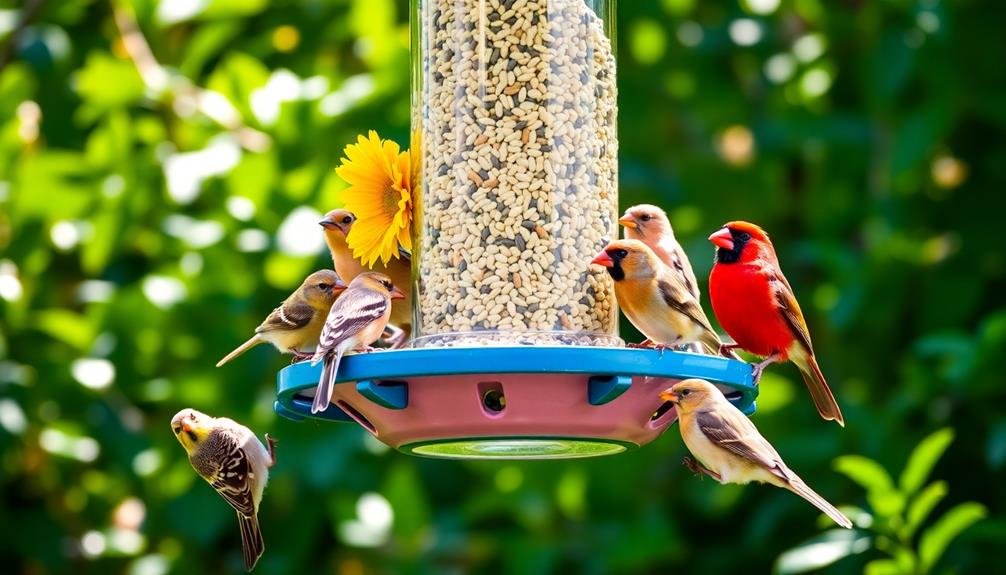
Choosing the right seeds can make all the difference in attracting a diverse array of birds to your feeder. Black oil sunflower seeds are a top choice, appealing to a wide variety of birds due to their high oil content and easy-to-crack shells.
Nyjer seeds, also known as thistle, are perfect for attracting finches and other small birds. Safflower seeds are favored by cardinals and chickadees while deterring squirrels.
For a varied diet that'll attract different species, contemplate offering a mix of seeds. You can create your own blend or purchase pre-mixed varieties. Some popular options include:
- Striped sunflower seeds
- White millet
- Cracked corn
- Peanuts (unsalted and raw)
Remember to contemplate the local bird species in your area when selecting seeds. Some birds prefer specific types of food, so research which species frequent your region.
It's also important to keep your seeds fresh and dry to prevent mold growth. Store them in airtight containers in a cool, dry place.
Creating a Bird-Friendly Garden
Beyond selecting the right seeds, creating a bird-friendly garden can greatly enhance your backyard's appeal to feathered visitors.
Start by incorporating native plants that provide natural food sources and shelter. Choose a variety of plants that bloom and produce berries at different times of the year to guarantee a steady food supply.
Add water features like birdbaths or small fountains to attract birds and provide them with a place to drink and bathe. Keep the water fresh and clean to prevent the spread of diseases.
Create different levels of vegetation by planting trees, shrubs, and groundcover to cater to various bird species' preferences.
Avoid using pesticides in your garden, as they can harm birds and reduce their food sources. Instead, encourage natural pest control by attracting beneficial insects.
Provide nesting materials like twigs, grass clippings, and pet hair in a mesh bag for birds to use in building their nests.
Lastly, consider adding birdhouses or nesting boxes to offer safe spaces for birds to raise their young. Position them away from predators and direct sunlight for the best results.
Mindful Bird Watching Techniques
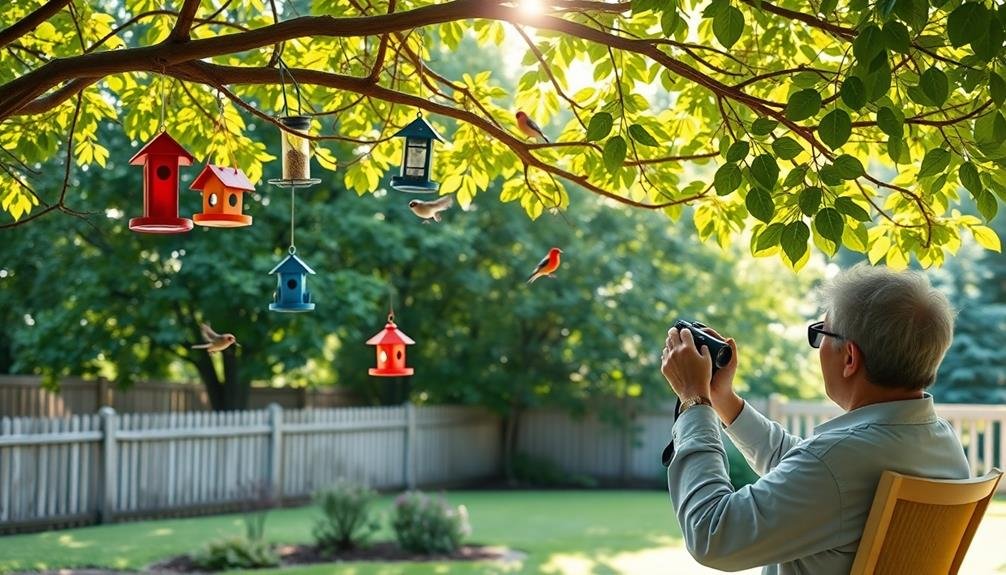
Mindful bird watching can considerably enhance the anxiety-reducing benefits of your backyard bird feeder. By practicing presence and focusing on the birds, you'll cultivate a sense of calm and connection with nature.
To begin, find a comfortable spot near your feeder and settle in quietly. Take a few deep breaths to center yourself and let go of racing thoughts.
As you observe the birds, engage your senses fully. Notice the colors of their feathers, the shapes of their beaks, and the patterns of their movements. Listen to their chirps and songs, paying attention to the different calls. You might even catch the subtle sound of wings fluttering.
To deepen your mindful practice, try these techniques:
- Count the number of different species you see in a set time frame
- Focus on one bird for several minutes, observing its behavior in detail
- Sketch or journal about the birds you're watching
- Practice gratitude by appreciating the beauty and diversity of your avian visitors
Seasonal Changes in Bird Behavior
As you observe birds at your feeder throughout the year, you'll notice significant changes in their behavior and feeding habits.
Migration patterns play an essential role, with some species disappearing for months while others arrive to take their place.
Your winter visitors may require high-energy foods like suet and sunflower seeds, while summer residents might prefer a variety of fruits and insects alongside seed offerings.
Migration Patterns Affect Feeding
When do you notice changes in the birds visiting your feeder? Migration patterns greatly impact the types and numbers of birds you'll see throughout the year. As seasons shift, so do the feeding habits and populations of your feathered visitors.
In spring and fall, you'll likely observe an influx of migratory birds stopping by for a quick refuel. These transient guests may include species you don't typically see year-round. During these peak migration periods, it's vital to keep your feeders well-stocked to support birds on their long journeys.
Summer brings breeding season, and you'll notice increased activity as parent birds frantically feed their young.
Winter, however, is when your feeder becomes a vital lifeline for many species struggling to find food in harsh conditions.
To accommodate these seasonal changes, consider:
- Offering a variety of seed types to attract different species
- Providing suet cakes in winter for high-energy nutrition
- Installing water sources, especially during dry spells
- Maintaining clean feeders to prevent disease spread among birds
Winter vs. Summer Diets
Birds' dietary needs shift dramatically between winter and summer. In winter, they require high-energy foods to maintain body heat and survive cold temperatures. You'll want to offer foods rich in fat and calories, such as suet, black oil sunflower seeds, and peanuts. These energy-dense options help birds build up essential fat reserves.
As spring arrives, birds' diets begin to change. They'll seek out more protein-rich foods to support breeding and nesting activities. Offer mealworms, nuts, and seed blends with a higher protein content during this changeover period.
In summer, birds have access to abundant natural food sources. They'll consume more insects, berries, and fruits. You can supplement their diet with fresh fruits, nectar feeders for hummingbirds, and a variety of seeds.
Provide clean water for drinking and bathing, which becomes increasingly important in hot weather.
Year-round, it's essential to maintain clean feeders and offer a diverse selection of foods. By adjusting your offerings to match seasonal needs, you'll create a welcoming environment for birds and enjoy their company throughout the year.
Identifying Common Backyard Birds
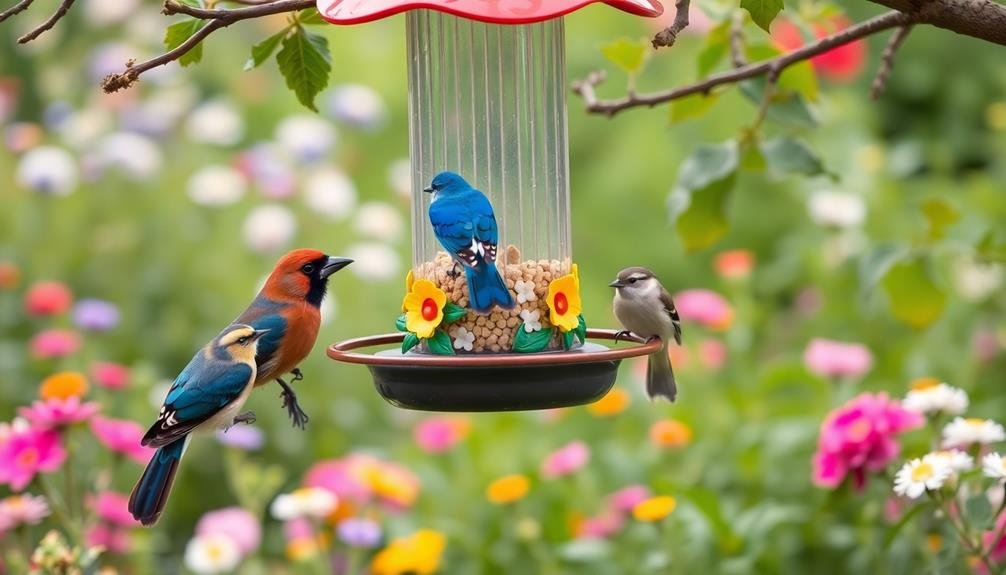
Spotting and naming the feathered visitors to your backyard can greatly enhance your bird-watching experience. You'll need a good field guide or a reliable bird identification app to help you recognize different species. Pay attention to key features like size, shape, color patterns, and behavior.
Listen carefully to their songs and calls, as these can be distinctive markers for many birds.
To become proficient at identifying common backyard birds, focus on these aspects:
- Silhouette: Observe the bird's overall shape and posture
- Bill shape: Look at the size and shape of the beak, which often indicates the bird's diet
- Markings: Note any distinctive patterns, stripes, or spots on the bird's plumage
- Habitat preferences: Learn which birds are likely to visit specific areas of your yard
Start with the most common species in your region, such as cardinals, chickadees, or finches. As you gain experience, you'll be able to identify more unusual visitors.
Don't get discouraged if you can't name every bird immediately; identification skills improve with practice. Keep a journal of your sightings to track your progress and enjoy the calming effects of observing nature.
Photography Tips for Bird Enthusiasts
For bird enthusiasts looking to capture stunning images of their feathered visitors, mastering the art of bird photography can be both rewarding and challenging.
To improve your shots, invest in a camera with a fast shutter speed and a telephoto lens. This setup will allow you to freeze motion and zoom in on distant birds without disturbing them.
Patience is key when photographing birds. Set up your camera near your bird feeder and wait quietly for the perfect moment. It's best to use a tripod to reduce camera shake and guarantee sharp images. Consider using a remote shutter release to minimize movement when taking photos.
Pay attention to lighting conditions. Early morning or late afternoon light can create beautiful, warm tones in your images. Avoid harsh midday sun, which can cast unflattering shadows.
When composing your shots, use the rule of thirds to create visually appealing images. Focus on the bird's eye for maximum impact.
Don't forget to experiment with different angles and backgrounds. Sometimes, including elements of the bird's natural habitat can add context and interest to your photos.
With practice and persistence, you'll soon be capturing breathtaking images of your backyard birds.
Maintaining Your Bird Feeding Station
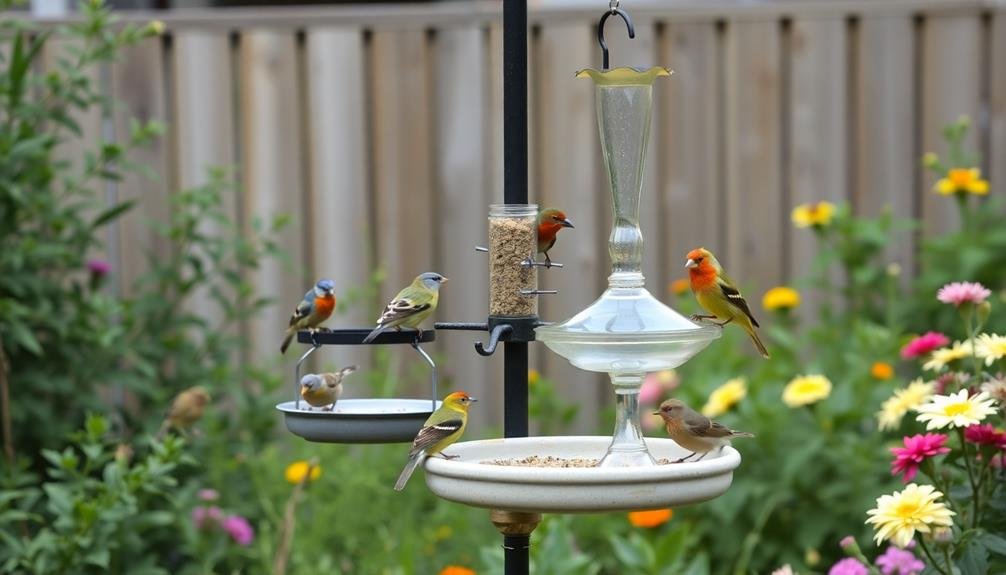
A clean and well-maintained bird feeding station is essential for the health and safety of your feathered visitors. Regular upkeep prevents the spread of diseases and guarantees that your backyard birds have access to fresh, nutritious food.
To keep your feeding station in top condition, you'll need to establish a routine cleaning schedule. Start by emptying and thoroughly cleaning your feeders at least once every two weeks. Use a mild soap solution and scrub brush to remove any built-up debris, then rinse and dry completely before refilling.
Don't forget to clean the area around your feeders, too. Rake up fallen seeds and droppings to discourage unwanted pests and maintain a hygienic environment.
Here are some additional maintenance tips to keep in mind:
- Inspect feeders regularly for damage or wear
- Replace moldy or wet seeds immediately
- Adjust feeder placement to protect birds from predators
- Provide fresh water daily in a clean birdbath
Benefits of Daily Nature Connection
Through daily interaction with nature, you can experience a multitude of benefits for your mental and physical well-being. Regularly observing and feeding birds in your backyard creates a calming routine that can greatly reduce stress and anxiety. You'll find yourself feeling more grounded and present as you watch these feathered visitors go about their daily activities.
Connecting with nature also improves your cognitive function. Spending time outdoors and focusing on birds can enhance your attention span and memory. It's a form of mindfulness that allows your brain to reset and recharge. You'll likely notice improved mood and increased energy levels as a result of this daily nature connection.
Moreover, tending to your bird feeding station encourages physical activity. You'll be moving around, refilling feeders, and maintaining your yard, which contributes to better overall health. This outdoor engagement can also boost your immune system and increase vitamin D levels through sun exposure.
Involving Family in Bird Watching
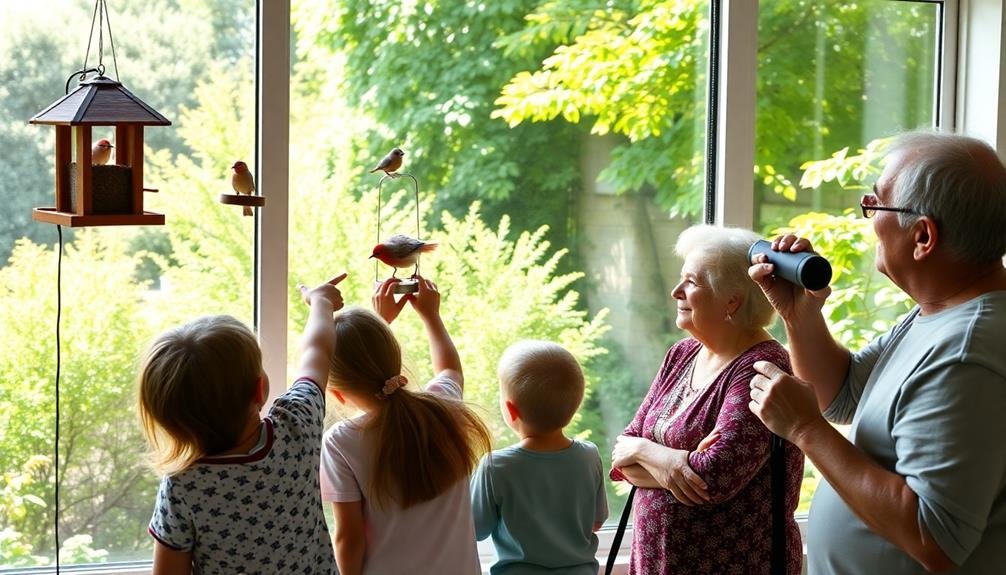
Beyond its individual benefits, bird watching can become a rewarding family activity that strengthens bonds and creates lasting memories. Encourage your children to participate by assigning them specific tasks, like refilling feeders or keeping a bird journal. You'll find that their natural curiosity and enthusiasm can reignite your own sense of wonder.
To make bird watching a family affair, try these engaging activities:
- Host a backyard bird identification contest
- Create homemade bird feeders together
- Plan weekend outings to local nature reserves
- Start a family bird photography project
As you involve your family, you're not just observing nature; you're fostering a shared appreciation for wildlife. This collective experience can lead to meaningful conversations about conservation, ecology, and the importance of protecting our environment.
You'll also find that bird watching provides a perfect opportunity to unplug from technology and reconnect with each other.
Don't be surprised if your family's newfound interest in birds extends beyond the backyard. You might soon find yourselves planning vacations around prime bird-watching locations or joining local ornithological societies.
Embrace this journey together, and watch as your family's bond grows stronger through your shared love of nature.
Bird Feeders and Local Ecosystems
Regularly, bird feeders play an essential role in supporting local ecosystems. They provide a reliable food source for native bird species, especially during harsh weather conditions or when natural food is scarce. By offering a variety of seeds, nuts, and fruits, you're helping to maintain biodiversity in your area.
Your bird feeder can attract a wide range of species, from common backyard visitors to rare migratory birds. This diversity contributes to the overall health of the ecosystem by supporting pollination, seed dispersal, and insect control. As birds visit your feeder, they'll also interact with other plants in your yard, potentially spreading seeds and promoting plant growth.
However, it's vital to maintain clean feeders to prevent the spread of diseases among bird populations. You should also be aware of local wildlife regulations and avoid attracting nuisance animals.
Frequently Asked Questions
Can Bird Feeders Attract Unwanted Pests Like Squirrels or Raccoons?
Yes, bird feeders can attract unwanted pests. You'll often find squirrels and raccoons trying to raid them. They're drawn to the easy food source. To deter them, you can use squirrel-proof feeders or place them strategically.
How Do I Prevent Window Collisions When Birds Visit My Feeders?
To prevent window collisions, place your feeders either very close to windows (within 3 feet) or far away (30+ feet). You can also use window decals, exterior screens, or UV-reflective films to make glass more visible to birds.
Are There Any Health Risks Associated With Handling Bird Feeders?
Yes, there are health risks when handling bird feeders. You can contract diseases like salmonella from bird droppings. Always wear gloves, wash your hands thoroughly, and clean feeders regularly to minimize these risks.
What Should I Do if I Find a Sick or Injured Bird Near My Feeder?
If you find a sick or injured bird, don't touch it. Call a local wildlife rehabilitator for guidance. Keep pets away and monitor the bird from a distance. If possible, secure the area to protect it from predators.
How Can I Deter Aggressive Birds From Monopolizing My Bird Feeder?
You can deter aggressive birds by using caged feeders, offering different types of food, placing multiple feeders apart, and installing baffles. You'll also want to temporarily remove feeders if bullying persists, allowing birds to disperse and resettle.
In Summary
You've now got the tools to create your own backyard bird sanctuary. By setting up feeders, choosing the right seeds, and creating a welcoming environment, you'll soon be surrounded by nature's melody. Remember, it's not just about attracting birds; it's about connecting with nature and finding peace in your own backyard. So take a deep breath, watch the birds, and let your anxiety melt away. Your feathered friends are waiting!





Leave a Reply